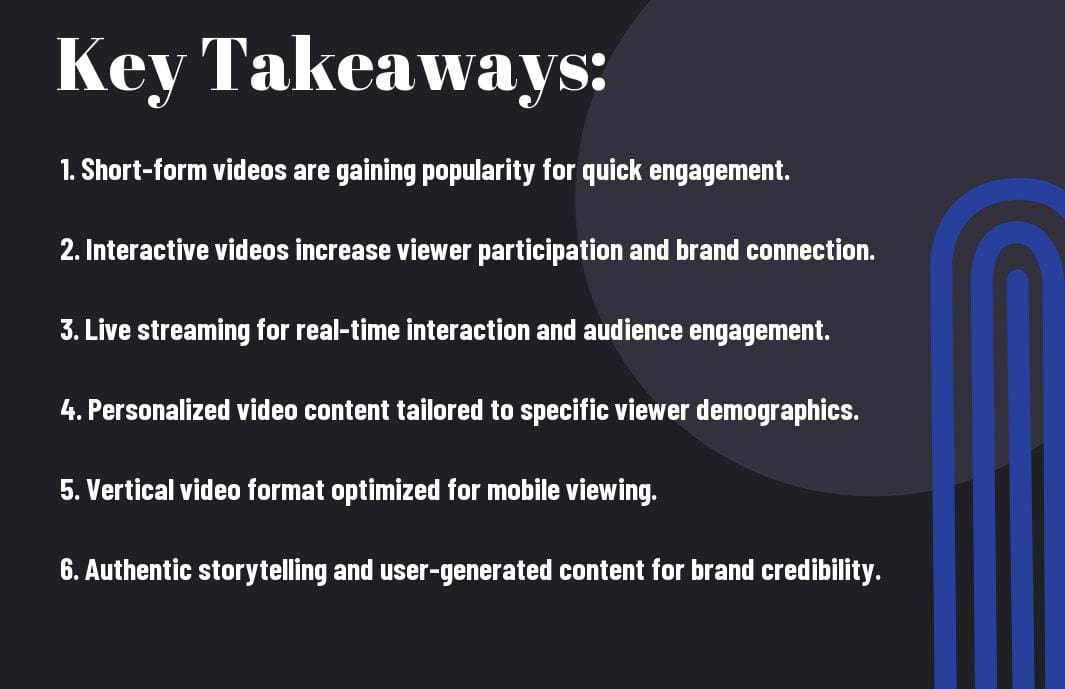Trends in video marketing are constantly evolving, adapting to consumer behaviors and technological advancements. Staying up-to-date with the latest trends is crucial for businesses looking to optimize their online advertising strategies. To help you stay ahead of the curve, we explore into the 9 Video Marketing Trends for 2024 highlighted in a recent article by Webfx. These trends provide valuable insights into where video marketing is headed and how you can leverage these developments to enhance your online advertising efforts.
9 Video Marketing Trends for 2024
Key Takeaways:
- Interactive Videos: Interactive videos have gained popularity in online advertising for their ability to engage viewers and provide a more personalized experience. Features like clickable links, quizzes, and 360-degree views can enhance user engagement and drive conversions.
- Short-Form Content: With the rise of platforms like TikTok and Instagram Reels, short-form video content has become a popular trend in video marketing. Brands are leveraging these platforms to create quick and engaging videos that cater to the short attention spans of online audiences.
- Live Streaming: Live streaming has become a powerful tool for online advertising as it allows brands to connect with their audience in real-time. Whether it’s hosting product launches, Q&A sessions, or behind-the-scenes glimpses, live streaming helps create authentic interactions and build trust with consumers.

The Rise of Short-Form Video Content
Even with the ever-decreasing attention spans of online audiences, short-form video content has seen a significant rise in popularity. Platforms like TikTok and Instagram Reels have played a pivotal role in shaping this trend, allowing users to create and consume bite-sized videos quickly and easily.
Understanding the Impact of Platforms like TikTok and Instagram Reels
Content on short-form video platforms typically ranges from 15 to 60 seconds in length, making them ideal for capturing viewers’ attention in a short amount of time. The algorithm-driven feeds of these platforms encourage addictive scrolling behavior, leading to higher engagement rates than traditional long-form content.
Best Practices for Crafting Short and Engaging Clips
Practices for creating compelling short-form video content include keeping the video concise, utilizing eye-catching visuals and music, and leveraging trends to stay relevant. Using text overlays for quick context and incorporating a strong call-to-action can also help drive audience interaction.
TikTok is at the forefront of the short-form video revolution, with its unique blend of user-generated content and algorithmic curation creating a platform ripe for viral trends and challenges. Brands that can adapt to the fast-paced nature of these platforms stand to gain significant visibility and engagement in the online advertising space.
Interactive Video Experiences
Incorporating Interactive Elements into Videos
Unlike traditional video content, interactive videos are designed to engage viewers on a whole new level. For many marketers, the challenge lies in incorporating interactive elements seamlessly into videos to enhance the overall viewing experience. This can include clickable hotspots, quizzes, polls, and even branching storylines that allow viewers to choose their own path through the video content.
How Interactive Videos Contribute to Customer Engagement
Videos have long been a powerful tool for capturing attention and conveying a message, but interactive videos take this a step further by driving customer engagement to new heights. By allowing viewers to actively participate in the content, whether through making choices, answering questions, or exploring different aspects of a product or service, interactive videos create a more immersive and personalized experience.
Interactive videos not only keep viewers actively engaged but also provide valuable data and insights into customer preferences and behavior. This information can then be used to tailor future marketing efforts and product developments, ultimately leading to a more positive and targeted customer experience.
Livestreaming as a Marketing Tool
The Growth of Real-Time Broadcasting
An increasing number of businesses are turning to live streaming as a powerful tool for engaging with their audiences in real-time. In today’s fast-paced digital world, consumers crave authentic, immediate interaction with brands, and livestreaming offers just that. Platforms like Facebook Live, Instagram Live, and YouTube Live have made it easier than ever for businesses to connect with their target market in a personal and meaningful way.
Strategies for Effective Livestreaming
Any successful livestreaming campaign requires careful planning and execution. To make the most out of this marketing tool, businesses should consider several key strategies. This includes setting clear goals for the livestream, choosing the right platform and time for broadcasting, promoting the event beforehand, and engaging with viewers in real-time. Businesses can also leverage influencers or collaborators to reach a wider audience and enhance credibility. Additionally, analyzing the data and feedback from each livestream can help refine future strategies for even better results.
Understanding the importance of proper equipment and technical setup is crucial for a successful livestreaming campaign. Poor video or audio quality can deter viewers and damage the brand’s reputation.
The Integration of Augmented Reality and Virtual Reality
Exploring AR in Advertising Campaigns
Reality: Not long ago, the idea of incorporating augmented reality (AR) into advertising seemed like a futuristic concept. However, with technological advancements and consumer demand for interactive experiences, AR has become a significant trend in video marketing. Marketers are now leveraging AR to create engaging campaigns that blur the lines between the virtual world and reality. By integrating AR elements into their ads, brands can offer consumers an immersive and interactive experience that drives engagement and boosts brand awareness. If you want to stay ahead of the curve and explore cutting-edge video marketing trends, check out 7 Huge Video Trends for 2024-2026 for more insights.
The Role of VR in Immersive Marketing
For: Not to be outdone, virtual reality (VR) is also making waves in the world of advertising. VR technology allows brands to create fully immersive experiences that transport consumers to virtual environments where they can interact with products and services in a unique way. With VR, marketers can tell compelling stories, showcase products in 3D, and offer virtual demos that give consumers a taste of what it’s like to use a product or service. The level of engagement and emotional connection that VR experiences provide can be a game-changer for brands looking to stand out in a crowded online advertising space.
With the increasing demand for personalized and interactive content, the integration of AR and VR in advertising campaigns is set to revolutionize the way brands connect with their audiences. By harnessing the power of these immersive technologies, marketers can create unforgettable experiences that leave a lasting impression on consumers and drive conversions like never before.
User-Generated Content and Community Building
Leveraging User-Generated Content for Authenticity
Once again, in video marketing for online advertising, user-generated content holds significant sway. Content created by users themselves has a certain level of authenticity that is hard to replicate through branded content. Leveraging user-generated content allows brands to connect with their audience on a more personal level, showcasing real people using their products or services in genuine ways. This authenticity can help build trust with potential customers and enhance brand loyalty.
Initiatives to Foster Brand-Customer Communities
User-generated content is closely tied to community building in the digital landscape. By encouraging customers to share their own content or experiences related to a brand, companies can create a sense of belonging and interconnectedness among consumers. These user-generated initiatives not only increase engagement but also foster a strong community around the brand, where customers can interact with each other and with the brand itself in a more meaningful way.
Authenticity plays a crucial role in these initiatives, as customers are more likely to engage with content that feels genuine and relatable. Brands that successfully foster brand-customer communities through user-generated content can benefit from increased brand advocacy, higher levels of customer loyalty, and valuable insights into consumer preferences and behaviors.
Video Optimization for Search Engines
SEO Best Practices for Video Marketing
Video optimization for search engines is a crucial aspect of video marketing for online advertising. By following SEO best practices, you can ensure that your videos are more likely to be discovered by your target audience. To optimize your videos for search engines, start by conducting keyword research to identify relevant keywords and phrases that your audience is searching for. Incorporate these keywords into your video titles, descriptions, and tags to improve the chances of your videos ranking higher in search results.
Understanding Video Analytics and Performance Metrics
The understanding of video analytics and performance metrics is important for measuring the success of your video marketing campaigns. By analyzing metrics such as views, watch time, engagement rate, and conversion rate, you can gain valuable insights into how your audience is interacting with your videos. This data can help you identify what is working well and what can be improved in your video marketing strategy.
The analysis of video analytics and performance metrics provides insights into how viewers are engaging with your content, allowing you to optimize your videos for better performance. By monitoring these metrics closely, you can make data-driven decisions to enhance your video marketing efforts and achieve greater success in reaching your target audience.
Plus, understanding the performance of your videos can help you allocate your budget more effectively, focusing on the videos and channels that are driving the most results. By continuously monitoring and analyzing video analytics, you can refine your video marketing strategy to maximize ROI and drive long-term success for your business.
The Future of Video Marketing
Predictions on New Technologies and Platforms
Many experts in the field of video marketing predict that new technologies such as virtual reality (VR) and augmented reality (AR) will revolutionize the way companies advertise their products and services online. These technologies have the potential to provide customers with immersive experiences that can engage them on a deeper level, ultimately leading to higher conversion rates. Additionally, with the rise of 5G technology, videos will load faster and in higher quality, further enhancing user experience.
Preparing for Changes in Consumer Behavior
Any successful video marketing strategy must also take into account the ever-changing landscape of consumer behavior. With the increasing popularity of voice search and smart speakers, companies will need to optimize their video content for voice queries to stay ahead of the competition. Additionally, the trend of consumers preferring authentic and personalized content will continue to grow, requiring brands to tailor their videos to specific target audiences.
An understanding of consumer behavior is crucial for businesses to effectively target their video marketing efforts. By staying informed on the latest trends and preferences of their target audience, companies can create videos that resonate with viewers and drive engagement.
Final Words
With this in mind, it is clear that video marketing is a powerful tool for online advertising that continues to evolve and innovate. The latest trends in video marketing, such as interactive videos, live streaming, and personalized video content, offer unique opportunities for businesses to engage with their audience in a more meaningful way. By staying up-to-date with these trends and incorporating them into their marketing strategies, companies can create compelling video content that resonates with consumers and drives results.
As technology advances and consumer preferences shift, it is vital for businesses to stay ahead of the curve when it comes to video marketing for online advertising. By embracing the latest trends and experimenting with new techniques, companies can set themselves apart from the competition and build a strong online presence. Ultimately, video marketing will continue to play a crucial role in the digital landscape, helping businesses connect with their target audience and achieve their marketing goals.
FAQ
Q: What Are the Latest Trends in Video Marketing for Online Advertising?
A: Video marketing is constantly evolving, and staying up to date with the latest trends is crucial for successful online advertising. Some of the current trends in video marketing include interactive videos, shoppable videos, personalized video content, live streaming, and 360-degree videos.
Q: How Important Is Video Marketing in Online Advertising?
A: Video marketing has become increasingly important in online advertising due to its ability to captivate audiences and convey messages effectively. With the rise of video platforms and social media, businesses are leveraging video content to boost engagement, brand visibility, and conversions.
Q: What Are Interactive Videos, and Why Are They Trending?
A: Interactive videos are a form of video content that allows viewers to engage with the video through clickable elements, quizzes, hotspots, and more. These videos are trending because they offer a unique and immersive viewing experience, increasing viewer engagement and interaction.
Q: How Can Shoppable Videos Benefit Online Advertising Campaigns?
A: Shoppable videos, also known as interactive or clickable videos, enable viewers to purchase products or services directly from the video. This seamless shopping experience can boost conversion rates, enhance the user experience, and drive sales for online advertisers.
Q: What Is Personalized Video Content, and How Does It Impact Online Advertising?
A: Personalized video content involves tailoring video messages to specific target audiences based on their preferences, behaviors, and demographics. This customized approach can increase viewer engagement, brand loyalty, and conversion rates in online advertising campaigns.
Q: Why Should Businesses Consider Incorporating Live Streaming into Their Video Marketing Strategy?
A: Live streaming allows businesses to connect with their audience in real time, humanizing their brand and fostering authentic interactions. By incorporating live streaming into their video marketing strategy, businesses can engage viewers, build trust, and drive engagement.
Q: How Can 360-Degree Videos Enhance the Viewer Experience in Online Advertising?
A: 360-degree videos allow viewers to control their viewing perspective by exploring the video content from different angles. This immersive technology can create a more captivating and interactive experience for viewers, leading to increased engagement and brand recall in online advertising.




